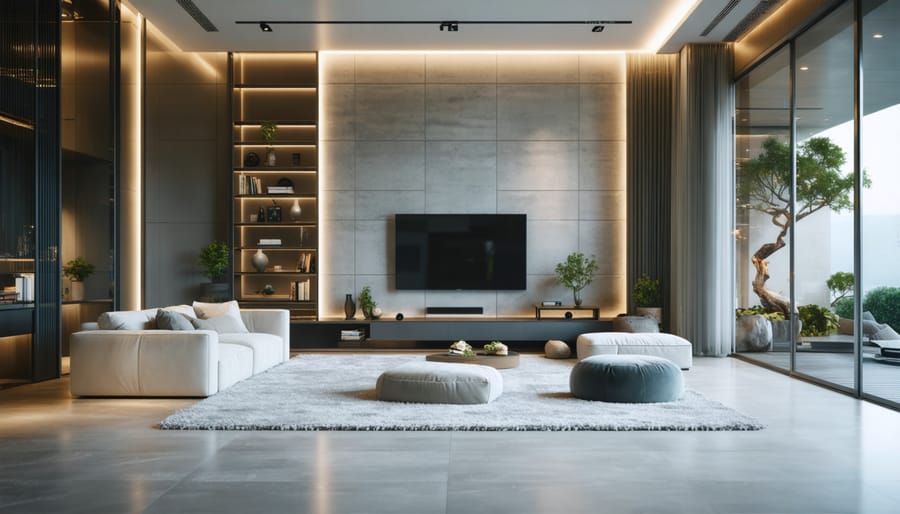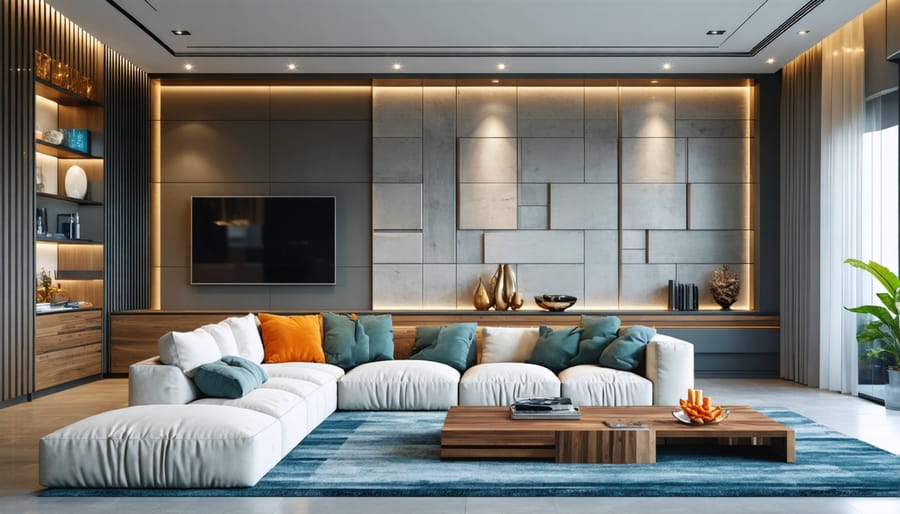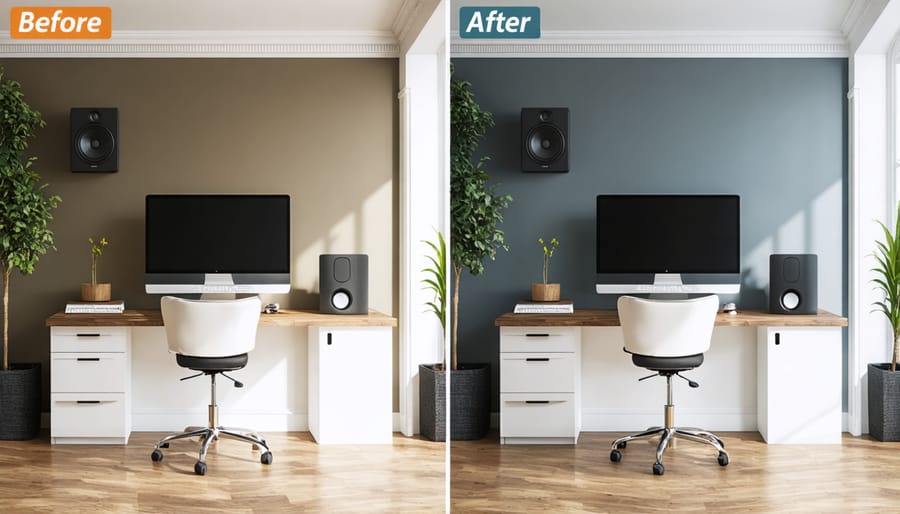
Transform Your Home’s Wellness with Smart Sound Design
Transform your living space into an acoustic sanctuary by mastering the fundamental principles of well acoustics – a key element among the dimensions of wellness. Sound waves dramatically impact our daily comfort, concentration, and emotional well-being, making acoustic design crucial for creating harmonious environments.
Strategic placement of sound-absorbing materials, from plush area rugs to textured wall panels, reduces unwanted noise reflection and creates a balanced auditory environment. Combine soft furnishings with hard surfaces to achieve optimal sound diffusion, while maintaining aesthetic appeal. Install acoustic ceiling treatments and strategically position furniture to break up sound paths and minimize echo.
Modern acoustic solutions seamlessly integrate with smart home technology, allowing precise control over sound management through automated systems and sound-masking devices. These innovations, paired with traditional acoustic principles, create spaces that not only sound better but feel more welcoming and peaceful. Whether you’re designing a home office, living room, or entire house, well-planned acoustics transform ordinary rooms into sophisticated, wellness-promoting environments.
How Sound Affects Your Daily Wellness

The Science of Sound and Stress
Recent studies have shown a direct link between poor acoustics and increased stress levels in our daily environments. When we’re exposed to unwanted noise or echo, our bodies respond by releasing stress hormones like cortisol, which can lead to anxiety, difficulty concentrating, and even elevated blood pressure.
Research from the World Health Organization indicates that prolonged exposure to poor acoustic environments can impact both our mental and physical well-being. In office settings, employees working in spaces with poor acoustics report up to 66% lower productivity levels and higher instances of workplace stress.
The human ear is remarkably sensitive to sound disturbances, and our brains are constantly processing acoustic information, even during sleep. When rooms have poor acoustic properties, such as excessive reverberation or sound reflection, our nervous system remains in a heightened state of alertness. This continuous state of arousal can lead to fatigue, irritability, and decreased cognitive performance.
Understanding these effects is crucial because it emphasizes how proper acoustic treatment isn’t just about comfort – it’s an essential aspect of creating healthy living and working spaces.
Creating Your Acoustic Comfort Zone
Different spaces in your home require different acoustic environments to support various activities. For optimal comfort, living rooms should maintain sound levels between 45-50 decibels (dB), creating a pleasant atmosphere for conversation and entertainment. Bedrooms benefit from lower levels, ideally between 30-35 dB, to promote restful sleep and relaxation.
Home offices need careful acoustic consideration, with recommended levels of 40-45 dB to maintain focus while allowing for clear communication during video calls. For media rooms or home theaters, aim for 40-45 dB of ambient noise, with the ability to control sound reflection for optimal audio experience.
Kitchens typically run louder, and it’s acceptable to have levels between 50-55 dB, but you’ll want to implement sound-dampening solutions for noisy appliances. Bathrooms benefit from sound levels around 40-45 dB, with extra attention paid to reducing echo and water noise.
Remember that these ranges are guidelines, and personal preference plays a significant role. Consider your daily activities and adjust accordingly – a musician might need different acoustic treatment than someone who primarily works from home.
Smart Solutions for Better Room Acoustics
Furniture Placement and Selection
Strategic furniture placement and selection play a crucial role in managing room acoustics. Start by considering soft, upholstered pieces that naturally absorb sound waves. Plush sofas, cushioned chairs, and fabric-covered ottomans can significantly reduce echo and reverberation in your space.
When arranging furniture, avoid creating parallel walls of hard surfaces. Instead, position larger pieces at slight angles to break up sound reflection patterns. Consider investing in ergonomic office furniture with sound-absorbing materials for workspaces where noise control is especially important.
Bookcases and shelving units filled with books can serve as excellent sound diffusers while maintaining functionality. Place these along walls where sound reflection is most problematic. For dining areas, choose tables with soft underlayment and chairs with upholstered seats to minimize noise from silverware and movement.
Consider incorporating modular furniture pieces that can be rearranged as needed to adjust room acoustics. Multi-functional furniture with built-in acoustic properties, such as storage benches with padded tops or room dividers with sound-absorbing panels, offers practical solutions for smaller spaces.
Remember to maintain clear pathways while arranging furniture – good acoustic design shouldn’t compromise flow or functionality in your space. Add area rugs under furniture groupings to further enhance sound absorption and create defined acoustic zones within larger rooms.
Sound-Absorbing Materials and Decor
Transform your space’s acoustics with strategic material choices that blend functionality and style. Soft, porous materials are your best allies in sound absorption, working to reduce echo and create a more peaceful environment. Start with larger surfaces like walls and floors, where materials like cork, acoustic panels, and thick carpeting can make a significant impact while adhering to universal design principles.
Textiles play a crucial role in sound management. Heavy curtains, especially those with pleats or multiple layers, not only control light but also absorb sound effectively. Upholstered furniture with plush fabrics helps trap sound waves, while decorative throw pillows and blankets add both comfort and acoustic benefits.
Consider these popular sound-absorbing materials and decor elements:
– Acoustic foam panels (can be disguised as art pieces)
– Fabric-wrapped wall panels
– Plush area rugs and runners
– Bookshelf arrangements (books are excellent sound absorbers)
– Living walls or vertical gardens
– Tapestries and wall hangings
– Acoustic ceiling tiles or suspended fabric panels
For a more subtle approach, incorporate sound-absorbing elements through everyday decor. Large indoor plants with broad leaves help diffuse sound while adding natural beauty. Strategic furniture placement, using pieces with soft surfaces, can create sound barriers and absorption zones throughout your space.
When selecting materials, consider their Noise Reduction Coefficient (NRC) rating – higher numbers indicate better sound absorption. Many manufacturers now offer specially designed acoustic materials that don’t compromise on style, including decorative wall panels, artistic ceiling elements, and sculptural room dividers that serve both aesthetic and acoustic purposes.
Remember that layering different materials and textures not only enhances sound absorption but also creates visual interest in your space. Mix and match elements like woven baskets, textile art, and plush seating to achieve both acoustic excellence and design harmony.

DIY Acoustic Improvement Projects
Transform your space with these simple yet effective DIY acoustic improvement projects that anyone can tackle over a weekend.
Bass Traps for Corners
Create basic bass traps by filling triangular frames with acoustic insulation. Cut three pieces of 2×4 lumber into 2-foot lengths, form a triangle, and cover with breathable fabric. Place these in room corners to reduce low-frequency resonance.
Fabric-Wrapped Panels
Build simple absorption panels using wooden frames (2×4 feet), rigid fiberglass insulation, and decorative fabric. Space these panels evenly on walls, focusing on areas opposite sound sources. For best results, mount them at ear level where sound reflection is most noticeable.
Bookshelf Diffusion
Arrange books of varying sizes on shelves to create natural sound diffusion. Place shelves on walls where sound tends to bounce, and stagger book depths to create an uneven surface that breaks up sound waves effectively.
Window Treatment Enhancement
Double up on curtains by installing both heavy drapes and sheer panels. This layered approach not only looks elegant but also provides variable acoustic control. Use curtain rods that extend beyond window frames for maximum coverage.
Door Seal Installation
Install weatherstripping and door sweeps to prevent sound leakage. Apply adhesive-backed foam tape around door frames and attach a door sweep to the bottom. This simple fix dramatically reduces sound transfer between rooms.
Floating Floor Overlay
Create a floating floor by laying interlocking cork or rubber tiles over existing flooring. This adds an extra layer of sound absorption without permanent modification to your space.
Remember to test acoustic improvements gradually, adding one element at a time to assess its impact. Take before and after recordings to measure the difference in sound quality. These projects can be customized to match your décor while effectively enhancing your room’s acoustics.
Room-by-Room Acoustic Strategy
Living Room and Entertainment Spaces
Living rooms and entertainment spaces present unique acoustic challenges as they often serve multiple purposes, from casual conversation to movie watching and music enjoyment. The key to achieving excellent acoustics in these areas lies in finding the right balance between sound absorption and reflection.
Start by identifying common acoustic issues in your space, such as echo, sound reverberation, or external noise interference. Large, flat surfaces like bare walls and windows are usually the main culprits behind poor acoustics. To address these challenges, consider incorporating soft furnishings like plush sofas, area rugs, and heavy curtains, which naturally absorb sound waves and reduce echo.
Strategic placement of furniture can also significantly impact acoustics. Position larger pieces against walls to break up sound reflection patterns, and arrange seating areas to create intimate conversation zones. For home theater setups, consider installing acoustic panels behind viewing areas and on side walls to enhance sound clarity without creating a deadened space.
Plants can serve as both decorative elements and natural sound diffusers. Large potted plants with broad leaves help break up sound waves while adding visual appeal. If you’re serious about home entertainment, consider installing specially designed acoustic treatments that complement your décor, such as decorative wall panels or artistic sound diffusers.
Remember that achieving good acoustics doesn’t mean completely eliminating all sound reflection – the goal is to create a balanced, comfortable environment that enhances both conversation and entertainment experiences.
Bedrooms and Quiet Zones
Creating a peaceful bedroom environment starts with proper acoustic treatment, as quality sleep depends heavily on minimizing disruptive sounds. Begin by identifying and addressing external noise sources, such as windows facing busy streets. Double-pane windows or specialized acoustic curtains can significantly reduce outside noise penetration.
For wall treatments, consider installing sound-absorbing panels behind your headboard or adding fabric-wrapped acoustic panels as decorative elements. Plush carpeting, area rugs, and heavy drapes not only add warmth to the space but also help absorb sound reflections. If you’re dealing with noise from adjacent rooms, installing sound-dampening insulation in shared walls during renovation can make a substantial difference.
For meditation spaces or reading nooks, focus on creating a balanced acoustic environment that promotes relaxation. Strategically placed bookshelves filled with books naturally absorb sound, while soft seating with upholstered surfaces helps maintain acoustic comfort. Consider adding white noise machines or small water features to mask any remaining unwanted sounds and create a soothing atmosphere conducive to rest and rejuvenation.
Home Office Sound Management
Creating an optimal acoustic environment in your home office is essential for maintaining focus and productivity. Start by identifying common noise issues like echo, external sounds, and equipment hum. A well-planned ergonomic home office setup should include sound management solutions that complement your workspace.
Consider adding sound-absorbing materials such as curtains, area rugs, or acoustic panels to reduce echo and minimize sound reflection. Strategic placement of furniture can help break up sound waves, while weatherstripping around windows and doors can block external noise. For computer and equipment noise, invest in quiet fans and place noisy devices on sound-dampening pads.
White noise machines or nature sound apps can help mask distracting background sounds without being intrusive. If you’re on a budget, simple solutions like bookshelf arrangements and soft furnishings can make a significant difference. Remember to test different configurations to find what works best for your specific space and needs.

Creating a harmonious acoustic environment in your space is more than just a luxury – it’s an investment in your wellbeing and quality of life. As we’ve explored throughout this guide, proper acoustic management can significantly impact everything from your stress levels and sleep quality to your productivity and overall satisfaction with your living or working space.
Remember that improving your space’s acoustics doesn’t have to be complicated or expensive. Start with simple solutions like strategic furniture placement and soft furnishings, then gradually implement more targeted solutions based on your specific needs and budget. Whether you choose to add acoustic panels, install sound-dampening curtains, or incorporate nature-inspired elements like indoor fountains, each step you take brings you closer to acoustic wellness.
Pay attention to how different acoustic modifications affect your daily experience. You might be surprised by how much calmer and more focused you feel in a well-balanced acoustic environment. For commercial property owners and businesses, good acoustics can translate into increased customer satisfaction and employee productivity.
Don’t hesitate to experiment with different solutions until you find what works best for your space. The journey to better acoustics is an ongoing process, and even small improvements can make a significant difference in your daily life. By implementing the strategies we’ve discussed, you’re not just controlling sound – you’re creating an environment that promotes wellness, comfort, and peace of mind.
